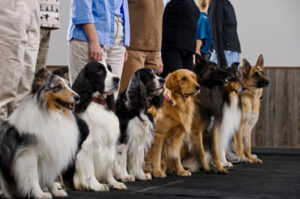It is an exciting and joyful time when you welcome a new pet into your life. The joy of pet ownership does, however, come with the duty of socializing and training your four-legged buddy. For you and your pet to have a pleasant and harmonious relationship, proper training and socialization are crucial.
Table of Contents
Introduction
Regardless of your pet’s age, breed, or species, this thorough guide will take you step-by-step through the process of pet socialization training. This page covers everything, from promoting pleasant connections between people and other animals to teaching the fundamentals of obedience and even training and socializing specific pets.

Recognizing The Value Of Pet Socialization Training
A well-behaved and balanced pet is shaped through pet socialization training. Both procedures are essential for safeguarding your pet’s overall health and developing a strong bond between you and your furry friend. Let’s explore the importance of training and socialization for pets.
To make your pet more attentive and responsive, training involves teaching them certain actions and orders. Early pet socialization training is crucial because young animals have more malleable minds and are more open to learning. It is best to begin at the puppy or kitten stage. Treats, adulation, and other forms of positive reinforcement are the cornerstones of effective pet socialization training. Rewarding your pet for desired behaviors makes them more likely to repeat them.
Beyond obedience, training and socialization for pets are crucial for their psychological well-being. Boredom and harmful actions may be prevented by keeping their minds active through training activities and mental stimulation. Dogs, for instance, flourish when given a goal and a task to do. By giving them mental challenges throughout training, you can keep their minds active and content.
To enhance your pet’s capacity for good interaction with the environment, socialization entails introducing them to a variety of people, animals, settings, and circumstances. Early training and socialization for pets are essential to averting subsequent fear, anxiety, and aggressiveness in pets, usually beginning in the first few months of a pet’s existence. Through pet socialization classes, pets may learn how to act correctly around people and other animals, which lowers the possibility of violent or frightened responses.
Your pet’s confidence grows as a result of positive socialization experiences, which equip them to tackle novel circumstances with ease. Pets that have received proper socialization tend to be more laid-back, flexible, and sociable, making them enjoyable companions in any environment.
Pet Training Socialization Classes In 5 Easy Steps

1. Establish Consistency
Establishing a daily schedule is the first step in starting pet socialization training. Particularly dogs and cats enjoy routine because it gives them a sense of security and predictability. Establish regular feeding, playing, walking, and training periods. Better outcomes will come from consistent training and socialization for pets. Therefore, by giving your pet regular pet training and socialization classes, they will soon learn what is expected of them.
2. Positive Reinforcement
The foundation for giving your pet “pet training and socialization classes” should be positive reinforcement. Reward your pet right away with goodies, praise, or love when they exhibit desirable behaviors, such as sitting or arriving when called. Your pet will want to repeat the activity because of the pleasant association.
3. Repetition
Always repeat the same commands for specific actions. For orders, use precise and constant verbal cues. Use a firm “come” for the recall order and a firm “sit” for the sitting command, for example. Cats and dogs may acquire the meaning of particular phrases through repetition since they are clever creatures.
4. Understanding Their Body Language
When teaching your pet, it’s important to understand their body language. Dogs, for instance, use their body language, tail wags, and facial expressions to communicate. You may prevent overloading your pet by modifying your training strategy when you notice symptoms of stress or pain.
5. Patience is the Key
The secret is to be patient. Keep in mind that every pet develops at its rate. While some people may pick up on instructions immediately, others could take longer. Avoid using punishment-based teaching techniques since they might foster distrust and dread. Instead, concentrate on recognizing success and promoting positive behavior.
Now let’s look at the things you must include in the training and socialization for pets
How to Housetrain Your Pet

A vital part of giving your pet training and socialization classes, especially for dogs and cats, is house training. Teaching your pet where and when to use the restroom is the main goal of house training.
Crate Training: Crate training is a successful approach for housebreaking dogs. Using a crate can encourage dogs to contain their urine and intestines until they are brought outdoors since dogs have a natural urge not to pollute their resting environment. Increase the amount of time your dog spends in the crate gradually, and be sure you always let them out of the box right away.
Positive Reinforcement: Give your pet quick praise and prizes when they go potty in the proper location. They learn that they’ve done something correctly when they receive praise. Scolding or penalizing mistakes should be avoided since it might cause confusion and worry.
Timetables: Set up a regular timetable for bathroom breaks. Take your pet outside at regular intervals throughout the day, particularly after meals and naps. They’ll establish a regular restroom pattern as they practice consistency.
If you have a cat, it is crucial to provide a clean litter box in a calm and convenient area. Although most cats use a litter box naturally, it’s important to keep it clean to promote regular usage.
Accidents can occur, particularly in the beginning phases of pet training and socialization classes. Your pet won’t have mishaps if you wipe up spills swiftly and completely with enzymatic cleansers to remove any remaining stink.
Walking Manners And Leash Training

Both dogs and cats who like taking walks outdoors need pet training socialization classes. They need to learn to understand the use of the leash. With the right leash training, your pet can walk behind you securely and without straining or getting too enthusiastic.
Dogs should be progressively introduced to the leash. Before fastening the leash to their collar or harness, let them sniff and examine it. To make the leash associated with pleasurable experiences, use goodies and encouraging reinforcement.
Avoid yanking on the leash when taking your dog for a walk. If they begin to pull, give gentle signals to refocus their attention. Reward your dog for following you while remaining calm. It takes time and effort to create a habitual walking style.
As a part of the pet socialization classes, teach your pet the right walking manners so that they can interact with other pets and people. Reward them for being calm by teaching them to sit or stay when others approach them. This stops any violent responses, like leaping or excessive barking.
Leash training for cats entails getting them used to wearing a harness. Let them wear the harness for brief durations each day to begin inside. Before taking your pet outside, gradually attach the leash and let it explore in a safe area.
Allow your cat to take the lead and stroll at their speed. Cats may not move in a straight line like dogs because they have a strong feeling of freedom. Give children space to climb trees and explore within certain bounds.
Modern Methods Of Training And Socialization For Pets

You can gradually shift to more difficult training methods once your pet has learned the fundamentals. These methods push your pet to pick up new abilities and behaviors while stimulating their minds.
Trick training
It is a fun and interesting approach to developing a relationship with your pet. Teaching them skills like “roll over,” “shake hands,” or “spin” not only amuses and entertains them but also strengthens the link between people and animals.
Agility training
It is a great way to keep your pet emotionally and physically healthy. Create an agility course with poles for weaving, jumps, and tunnels, then guide and reward your pet as they move through it.
Puzzle Toys
Pets get cerebral stimulation through puzzle toys and activities. For instance, food puzzle toys need your pet to solve a riddle to reach the rewards within. These toys stimulate their minds and keep them from getting bored.
Clicker Training
An effective technique for modifying desired behavior is clicker training. The clicker is a little, portable gadget with a distinctive sound. It captures the precise instant your pet behaves appropriately, and you then reinforce that behavior with a reward. The clicker facilitates clear communication, which makes it simpler for your pet to comprehend what is being asked of them.
To get the most out of your advanced training, make sessions brief and fun. To keep your pet engaged and eager to learn throughout the following session, end on a good note.
Note: There might be affiliate links mentioned here. We may receive a commission if you purchase a product through an affiliate link. There is no additional charge for you. Please do your own research before making any online purchases.
Pet Socialization Training
An important part of your pet’s development is exposing them to other animals through socialization. Whether you have a dog, cat, or another species, early exposure to diverse animals can have a good long-term influence on their relationships and behavior.
Early training and socialization for specific pets are very useful. Pups can socialize with other pups in a secure setting during these lessons, encouraging positive play habits and boosting their self-assurance with canines.
In training and socialization for specific pets of older age, pick a safe area to introduce your mature pet to other pets. Let the pets sniff and meet one another while keeping a tight eye out for any symptoms of discomfort or hostility. Refocus their attention on pleasurable interactions and incentives if any indications of strain start to appear.
In training and socialization for specific pets like cats, note that it is possible to socialize cats with other cats, but it takes time and gentle introductions. Start by putting the new cat’s essentials in a different room so the current cat can sniff it beneath the door and become used to it. Introduce them gradually while watching them attentively through a baby gate or a cracked door.
With the right introductions and supervision, your pets can largely benefit from the pet socialization classes you give them. Before making immediate contact, let them watch each other from a safe distance. Always keep an eye on how they are acting and take measures if required.
Pet Socialization Training With People

For their safety and well-being, you must teach your pet to feel at ease among people, especially strangers and young children.
Early exposure to a range of individuals helps dogs develop into more welcoming and sociable animals. Enroll your puppy in puppy school or take them to pet-friendly gatherings to meet new people. Treats and praise should be used to reinforce positive relationships.
Dogs: Whenever introducing your dog to a new person, always get their permission first. Don’t overload your dog with too many new faces at once; instead, let them come in on their own time.
Cats: Early handling of cats by various individuals is crucial. By rewarding your kitten with snacks and playtime, you may encourage it to socialize with friends and family. If your cat feels uncomfortable, don’t force them to interact.
While giving your pets these pet socialization classes, don’t force interactions if your pet exhibits signs of fear or anxiety while among strangers. Instead, make a place where kids can go when they’re feeling overwhelmed. They may eventually feel more comfortable with you if you expose them gradually and encourage them.
Behavioral Issues Management

Even with our greatest efforts, certain pets could experience behavioral problems that call for attention and treatment. To adopt practical remedies, it is imperative to comprehend the underlying causes of these issues.
Aggression
It is a typical behavioral problem that can take many different forms, including food aggression, territorial aggressiveness, and hostility motivated by fear. It’s critical to deal with the underlying causes of hostility. To develop a behavior modification strategy specifically suited to the requirements of your pet, speak with a qualified animal behaviorist or trainer. That way, you can get an idea of how to socialize a reactive pet.
Separation Anxiety
Another prevalent issue is separation anxiety, particularly in dogs. When left alone, dogs with separation anxiety engage in destructive activity, loud barking, and improper urination. Separation anxiety may be reduced by gradually desensitizing your pet to your absence as well as by offering them toys that are mentally stimulating and relaxing techniques.
Boredom or worry
It can lead to destructive activity, such as chewing on furniture or digging. This energy may be redirected into productive pursuits by providing lots of mental and physical stimulation through toys, games, and frequent exercise.
The establishment of a safe and secure environment is essential for pets displaying fearful or nervous behavior, such as excessive hiding or trembling. Anxiety can be lessened by using counter-conditioning tactics, such as connecting frightful stimuli with pleasant experiences.
In the training process, patience is essential since behavioral difficulties take time to resolve. Punishment-based techniques should be avoided since they may worsen the issue and increase your pet’s fear and anxiety.
Training And Socialization For Specific Pets
It’s important to adjust your strategy to your pet’s species and distinct characteristics because training and socialization for pets have varying requirements based on the pet and breed.
Socialization and Training of Dogs:
Dogs are pack animals by nature and thrive in social settings. It is essential for their mental health and behavior to socialize with other dogs and people. Dogs can benefit from regular physical activity, strolls, and trips to dog parks for socializing opportunities.
During training, emphasize consistency and clear communication. Dogs enjoy a consistent schedule and rewards for excellent behavior. Keep in mind that your dog’s breed-specific characteristics should be taken into account, as certain breeds may demand more mental and physical stimulation than others.
Socialization and Training of Cats:

Although cats are more autonomous than dogs, socializing can still be beneficial to them. By treating kittens gently and introducing them to various situations, you can begin socializing kittens as early as possible. Using a scratching post rather than furniture is one example of how positive reinforcement may promote desirable behavior.
It is possible to train cats to do tricks, but it takes time and a thorough grasp of their motives. Reward desired actions with sweets and playtime. Keep in mind that each cat has a different personality, and some may be less inclined to obey directions than others.
Socialization and Training for Adopted or Rescued Pets
Pet adoption can sometimes present some special difficulties. Numerous adopted or rescued animals have unknowable pasts or traumas that may have an impact on their behavior and socialization.
Spend some time learning about the history of adopted pets and any possible triggers that might lead to dread or anxiety. Allow them time and space to explore at their own speed while they become used to their new surroundings.
Cats: It’s crucial to provide a secure environment for rescued cats when adopting them. Allow them to start interacting; don’t give them too much attention at first. Introduce them to family members and other pets gradually.
Dogs: Rescued dogs may require more time to socialize and train, but with love, persistence, and praise, they may develop into wonderful companions.
FAQs
Why is training and socialization for pets important for the welfare of my pet?
The general health of your pet depends on training and socializing since they help create a companion that is well-mannered and balanced. Pet socialization training aids in preventing fear, anxiety, and hostility in a variety of settings, whereas training fosters compliance and response.
At what age should I begin training and socialization for pets?
It is preferable to begin the training and socialization for pets when it is still a puppy or kitten. Animals that are young have minds that are more flexible and open to learning. Future habits are built on a solid foundation created by early teaching.
How can training and socialization for pets benefit from positive reinforcement?
When your pet displays desirable behaviors, positive reinforcement entails rewarding them with goodies, compliments, or affection. This encouraging association encourages them to repeat those behaviors, which increases the training’s effectiveness and makes it more fun for both of you.
Can training and socialization for pets stop my pet from acting out destructively?
Yes, training may help your pet avoid destructive habits. By keeping their minds active with mental activities and stimulation, we may help them release their energy and avoid boredom, which is frequently a major trigger for harmful actions.
In what ways do pet training socialization classes help my pet?
Your pet will benefit from pet socialization training by being exposed to a variety of people, animals, and situations, which will help them learn how to connect well with others. Their confidence increases as a result of proper socialization, which also makes them more at ease, flexible, and amiable in many situations.
Does enrolling my dog in pet socialization classes make sense?
Pet socialization classes can be a great way to help your dog. Puppies can engage with others in a secure setting during these lessons, which encourages positive play behaviors and boosts their self-assurance around other dogs.
What’s the greatest approach to pet socialization training?
Allow your pet to approach others at their own speed when first introducing them to others. Always get someone’s permission before doing anything. Reward pleasant encounters with food and praise and avoid overloading your pet with too many new faces at once.
Can training and socialization for pets assist with behavioral problems?
Yes, training and socialization for pets can assist your pet’s behavior problems. You may change their behavior and establish a more peaceful connection by comprehending the root reasons for the issues and using positive reinforcement strategies.
How do I deal with my pet’s house-training mishaps?
Avoid reprimanding or penalizing your pet for accidents that occur when house training. Instead, use enzymatic cleansers to quickly and completely clean up the issue in order to get rid of any remaining scents. This makes it more difficult for your pet to return to the same location.
Can I leash-train my cat?
Cats can be trained to use a leash. Before connecting the leash, start by getting them used to wearing a harness inside. Prior to going outside, let your cat explore in a safe setting. During walks, always allow your cat to take the lead and explore at their own speed.
Conclusion
Training and socialization for pets are essential components of good pet keeping. You may create a close link with your animal buddy and make sure they are well-behaved and well-adjusted family members by spending time, patience, and positive reinforcement. Your efforts will be rewarded with a joyful and peaceful relationship between you and your cherished pet, from simple instructions to complex tricks and social interactions.












